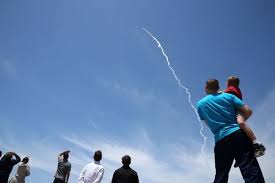On May 31, 2017, US military conducted a successful missile defence test involving a simulated attack by an intercontinental ballistic missile (ICBM).
Details about the test of ICBM Defense system:
- Firstly an ICBM-type missile was fired from the Kwajalein Atoll in the Marshall Islands toward the waters at south of Alaska.
- Thereafter, a rocket was fired from the Ground-based Midcourse Defence (GMD) system from Vandenberg Air Force Base in California which deployed an ‘exo-atmospheric kill vehicle’ that smashed into the ICBM-type missile and thereby destroyed it completely.
US shield against North Korean Missiles:
The test was conducted in order to assess preparedness for countering any threats through ICBMs from North Korea.
- It is to be noted that North Korea has been frequently conducting missile tests, which defence experts have dubbed as repeated attempts to improvise its strike capability on US through ICBMs.
- United States is at 9,000 km distance from North Korea. ICBMs have a minimum range of about 5,500 km, but some are designed to travel as far as 10,000 km.
About Ground-based Midcourse Defense (GMD) System:
Ground-Based Midcourse Defense(GMD) is the United States’ anti-ballistic missile system for intercepting incoming warheads in its airspace, during the midcourse phase of ballistic trajectory
- It is administered by the S.Missile Defense Agency (MDA) with technical support from US Army and US Air Force.
- Defence experts within and outside US, believe that this system has limited reliability in shielding US from ICBMs as it has a low strike rate. In tests conducted from 1999 to 2014, GMD hit the target in only 9 out of 17 tests.
- However, in the budget proposal for the fiscal year 2018, Pentagon has requested $7.9 billion for the Missile Defense Agency, which includes about $1.5 billion for the GMD program.
AffairsCloud Recommends Oliveboard Mock Test
AffairsCloud Ebook - Support Us to Grow
Govt Jobs by Category
Bank Jobs Notification




